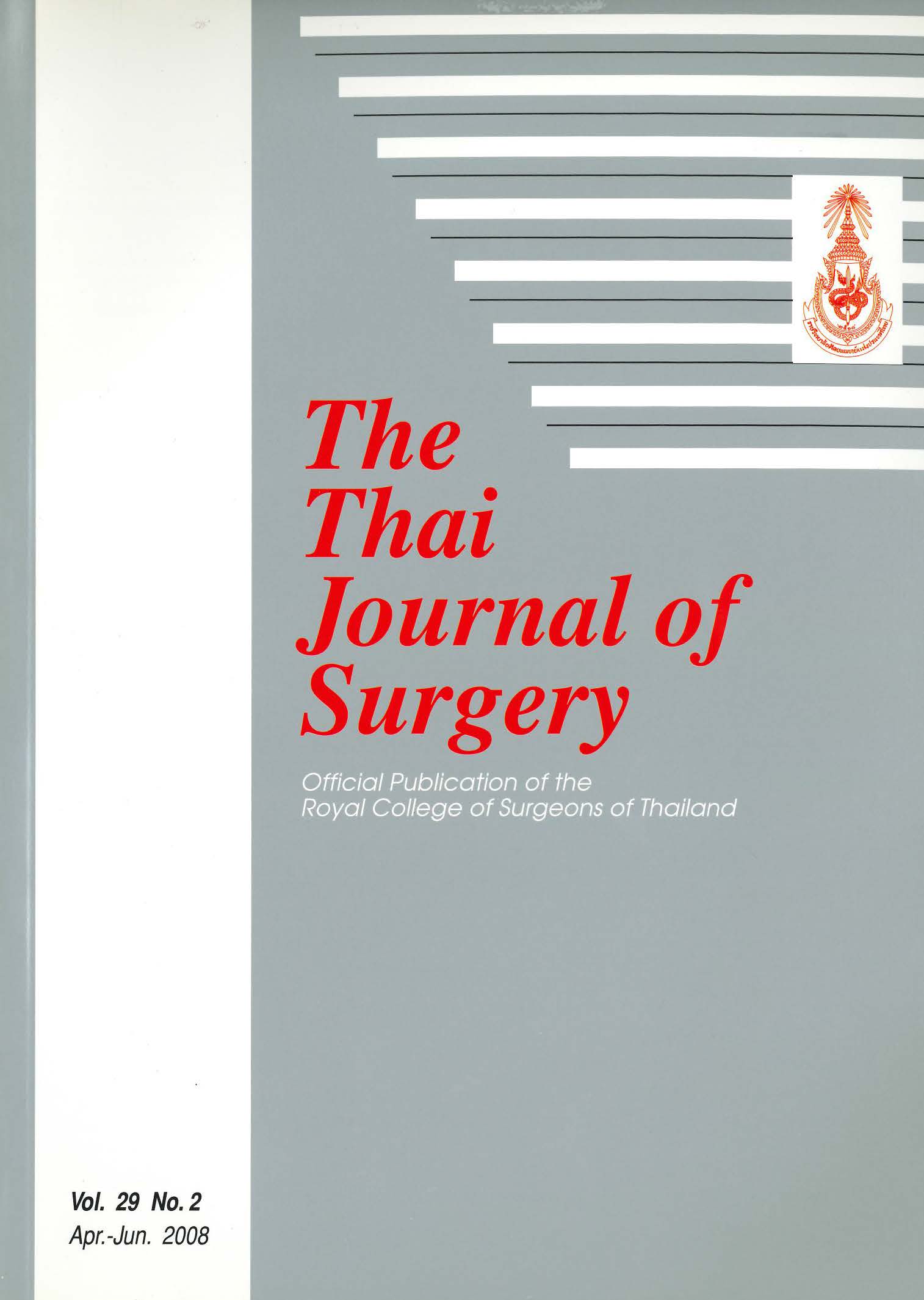The Power Setting of Endovenous Microwave Ablation for the Treatment of Varicose Vein: In Vitro Study
Abstract
Introduction: Traditional treatment of greater saphenous vein (GSV) reflux has been surgical removal of the GSV. Ablation of the vein by endovenous laser therapy (EVLT) and radio frequency endovenous ablation (VNUS Medical Technologies) are newer techniques which are less invasive and with lower complication rates. Microwave ablation is a sub-type of radiofrequency which has the same characteristic as radiofrequency ablation. This study aimed at finding the appropriate power setting of microwave ablation applied for the treatment of varicose vein that has no further damage to other surrounding tissue.
Material and Methods: Two patients with symptoms of varicose vein were enrolled in this study. Greater saphenous vein (GSV) stripping was performed and the veins were used for this study. Six segments of 10 cm long of greater saphenous veins were inserted into the subcutaneous layer which adhered to muscle layer of swine model via the probe. The swine meat was divided into 6 groups. Heparinized blood was filled into the lumen of greater saphenous vein of each group. Microwave generator (MICROTAZE OT -110M) with catheter was used in this study. The cut pieces were labeled as C (control), S (sham), 40, 50, 60 and 70. No additional procedure was performed in group C. Endoluminal microwave catheter was applied with power generator at 0, 40, 50, 60 and 70 Watts in group S, 40, 50, 60 and 70 respectively. Endoluminal microwave catheter was pulled back at 0.5 cm per 10 seconds. The swine meat in each group was sent for pathological examination and was each sectioned into 10 pieces.
Results: Normal venous walls were found in C and S group. In 40 Watt group, the burning depth to tunica adventitia was found in 5 of 10 pieces. In 50 Watt group, the burning depth to tunica adventitia was found in 9 of 10 pieces with 20% circumferential extra luminal tissue damage (mean distance 897 ± 942.98 micron). In 60 Watt group, the burning depth to tunica adventitia was found in all 10 pieces with 75% circumferential extra luminal tissue damage (mean distance 843 ± 343.65 micron). In 70 Watt group, the burning depth to tunica adventitia was found in all 10 pieces with 51% circumferential extraluminal tissue damage (mean distance 1207 ± 953.79 micron).
Discussion: The appropriate power setting of endovenous microwave ablation for the treatment of varicose vein should be in the range of 50-60 Watts which gives best result by causing venous tissue damage of all layer with minimal extraluminal tissue damage.
References
2. Min RJ, Khilnani NM. Endovenous laser ablation of varicose vein. J Cardiovasc Surg 2005;46:395-405.
3. Proebstle TM, Moeler T, Gul D, Herdemann S. Endovenous treatment of Great Saphenous Vein using a 1,320 nm Nd:YAG laser cause fewer side effect than using 940 nm Nd:YAG laser. Dermatol Surg 2005;31:1678-84.
4. Chang CJ, Chua JJ. Endovenous laser for varicose veins. Laser in Surgery and Medicine 2002:32:257-62.
5. Navarro L, Min RJ. Endovenous laser, a new minimally invasive method of treatment of varicose veins – preliminary observations using a 810 nm diode laser. Dermatol Surg 2001;27:117-122.
6. Proebstle TM, Gul D, Lehr HA, Infrequent early recanalization of greater sarphenous vein after endovenous laser treatment. J Vasc Surg 2003;38:511-6.
7. Min RJ, Khilnani NM. Endovenous laser treatment of saphenous vein reflux. Technique in Vascular and Interventional Surgery 2003;6:125-31.
8. Min RJ, Khilnani N, Zimmet SE. Endovenous laser treatment of saphenous vein refluxะ long term results. J Vasc Intervent Radiol 2003;14:991-9.
9. Merchant RF, Pichot O. Long term outcomes of endovenous radiofrequency obliteration of saphenous reflux as a treatment for superficial venous insufficiency. J Vasc Surg 2005;42:502-9.
10. Weiss RA, Controlled radiofrequency endovenous occlusion using a unique radiofrequency catheter under duplex guidance to eliminate saphenous varicose vein reflux, A2-year follow-up. Dermatol Surg 2002;28:38-42.
11. Wagner WH, Levin PM, Cossman DV, Cohen JL. Early experience with radiofrequency ablation of greater saphenous vein. Ann Vasc Surg 2004;18:42-7.
12. Paggioni A, Kalra M, Carno M, Mozes G. Endovenous laser therapy and radiofrequency ablation of the great saphenous vein: analysis of early efficacy and complications. J Vasc Surg 2005;42:488-93.
13. Morrison N. Saphenous ablation: what are the choices, Laser or RF. Sem Vasc Surg 2005;18:15-8.
14. Perrin M. Endoluminal treatment of lower limb varicose veins by endovenous laser and radiofrequency techniques. J Phleb 2005;19:170-8.
15. Lurie F, Creton D, Ekof B, Pichot O, Prospective randomized study of endovenous radiofrequency obliteration versus stripping in selected patient (EVOLVe Study), J Vasc Surg 2003;38:207-214.
16. John J, Norman H, Eric L. Surgical and endovascular treatment of lower extremities venous insufficiency. J Vasc Intervent Radiol 2002;13:563-58.
17. Simon CJ, Dupuy DE, Mayo-Smith W. Microwave ablation; principles and applications. J Radiograph. 2005;25:69-83.
Downloads
Published
How to Cite
Issue
Section
License
Articles must be contributed solely to The Thai Journal of Surgery and when published become the property of the Royal College of Surgeons of Thailand. The Royal College of Surgeons of Thailand reserves copyright on all published materials and such materials may not be reproduced in any form without the written permission.



